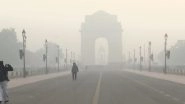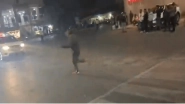Kerala, often referred to as God’s Own Country is marked by endless green hills stretched gently into the distance, adorned with lush tea plantations and cascading waterfalls. People nationwide love the peace and tranquillity that the place resonates. However, a recent landslide in Wayanad had a different story to tell. The landslide claimed the lives of over 200 people. Typically promoted as a premier tourist destination, Kerala has issued a rare warning to stay away. The Kerala Police have urged people to refrain from engaging in dark tourism, which could interfere with ongoing rescue efforts in Wayanad. But what is dark tourism that the Kerala Police are talking about? Let’s delve into the details of dark tourism and its prevalence worldwide.
What Is Dark Tourism?
Dark Tourism is a term that might sound ominous, but it refers to a form of travel that has been gaining popularity over the years. This type of tourism involves visiting places associated with death, tragedy, and disaster. These sites often have historical significance and provide a unique, albeit sombre, perspective on human history and resilience. From battlefields and war memorials to sites of natural disasters, dark tourism invites visitors to reflect on the darker aspects of the human experience.
What Happened in Kerala?
A devastating landslide that struck Mundakkai and Choooralmala has left the dead without even a final resting place in their home villages. A nearby bridge used to enter Attamala in Mundakkai also collapsed. The death toll from the landslide has crossed 200, where hundreds have been injured and thousands have been displaced. Regarding this, Kerala Police have urged people to avoid dark tourism in Wayanad while rescue operations are underway. The police took to X (formally known as Twitter) and posted, “Do not head to tragedy-hit spots for sightseeing. It will affect rescue operations. For help, please call 112.”
Post by Kerala Police
ദയവായി കാഴ്ചകൾ കാണാൻ ദുരന്ത പ്രദേശങ്ങളിലേക്ക് പോകരുത്🙏🏻
അത് രക്ഷാപ്രവർത്തനത്തെ ബാധിക്കും
സഹായങ്ങൾക്ക് 112 എന്ന നമ്പറിൽ വിളിക്കാം #keralapolice pic.twitter.com/D6irnQICNJ
— Kerala Police (@TheKeralaPolice) July 30, 2024
Why is Dark Tourism Popular?
Dark tourism appeals to a range of motivations. For some, it is an opportunity to pay homage to the victims and learn about historical events firsthand. For others, it is a way to confront and understand the darker side of human nature and the impact of catastrophic events. However, it is not a new phenomenon. “There’s evidence that dark tourism goes back to the Battle of Waterloo where people watched from their carriages the battle taking place," J John Lennon, a professor of tourism who coined the term told The Washington Post.
There has been an increasing growth in the number of visitors visiting places of tragedy. According to the survey by Passport-photo.online, over 900 Americans, 82 per cent of the people, have at least visited one of the dark tourist places. Some enjoy its educational aspect or pay tribute to the people affected by the grief event, while others want to get emotionally absorbed in a place of tragedy. Sites like Auschwitz in Poland, Ground Zero in New York, and Chernobyl in Ukraine are among the most visited dark tourism destinations globally, each offering a stark reminder of past tragedies and their enduring impact on humanity. Even in India, people visit sites like Port Blair's Cellular Hail, Uttarakhand's Roopkund Lake or Kuldhara of Jaisalmer to witness sites associated with tragedy or sufferings.
Global Hotspots of Dark Tourism
Auschwitz-Birkenau, Poland: Perhaps the most infamous of all dark tourism sites, this former Nazi concentration camp serves as a powerful reminder of the Holocaust. Visitors can tour the camp and witness the harrowing conditions endured by millions of Jews and other persecuted groups during World War II.
Chernobyl, Ukraine: The site of the catastrophic nuclear disaster in 1986, Chernobyl has become a dark tourism hotspot. Tours take visitors through the abandoned town of Pripyat and offer insights into the events leading up to the disaster and its long-term consequences.
Ground Zero, New York, USA: The site of the 9/11 terrorist attacks, Ground Zero is a place of remembrance and reflection. The National September 11 Memorial & Museum honours the nearly 3,000 victims and provides a narrative of the events and their aftermath.
Hiroshima, Japan: The Hiroshima Peace Memorial Park and Museum commemorate the victims of the atomic bomb dropped in 1945. The site is a poignant reminder of the devastating effects of nuclear warfare and a call for peace.
Pompeii, Italy: The ancient city of Pompeii, buried by the eruption of Mount Vesuvius in AD 79, attracts millions of visitors each year. The well-preserved ruins offer a glimpse into Roman life and the sudden, tragic end of a bustling city.
Dark tourism, while offering a unique perspective on historical tragedies and human resilience, requires a careful balance of curiosity and respect. In the wake of the recent landslide in Wayanad, Kerala has urged potential tourists to refrain from visiting the affected area to allow rescue operations to proceed unimpeded. This appeal underscores the ethical considerations inherent in dark tourism. Dark tourism is not merely about witnessing tragedy but about honouring the memories of those who suffered and understanding history lessons to build a more empathetic and informed future.
(The above story first appeared on LatestLY on Aug 01, 2024 10:47 AM IST. For more news and updates on politics, world, sports, entertainment and lifestyle, log on to our website latestly.com).













 Quickly
Quickly


